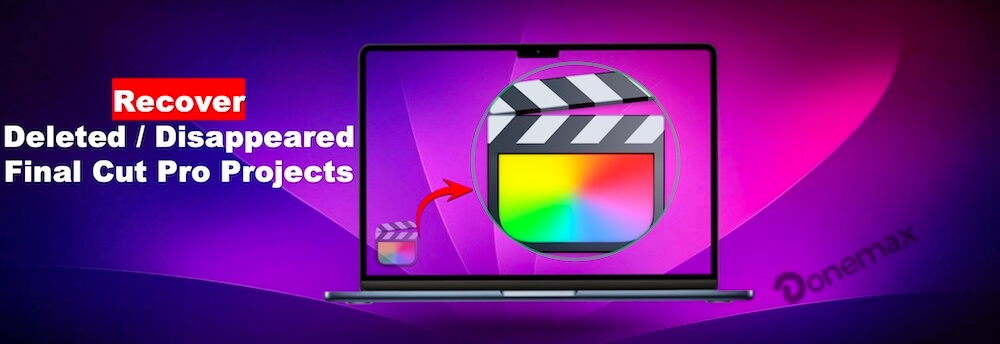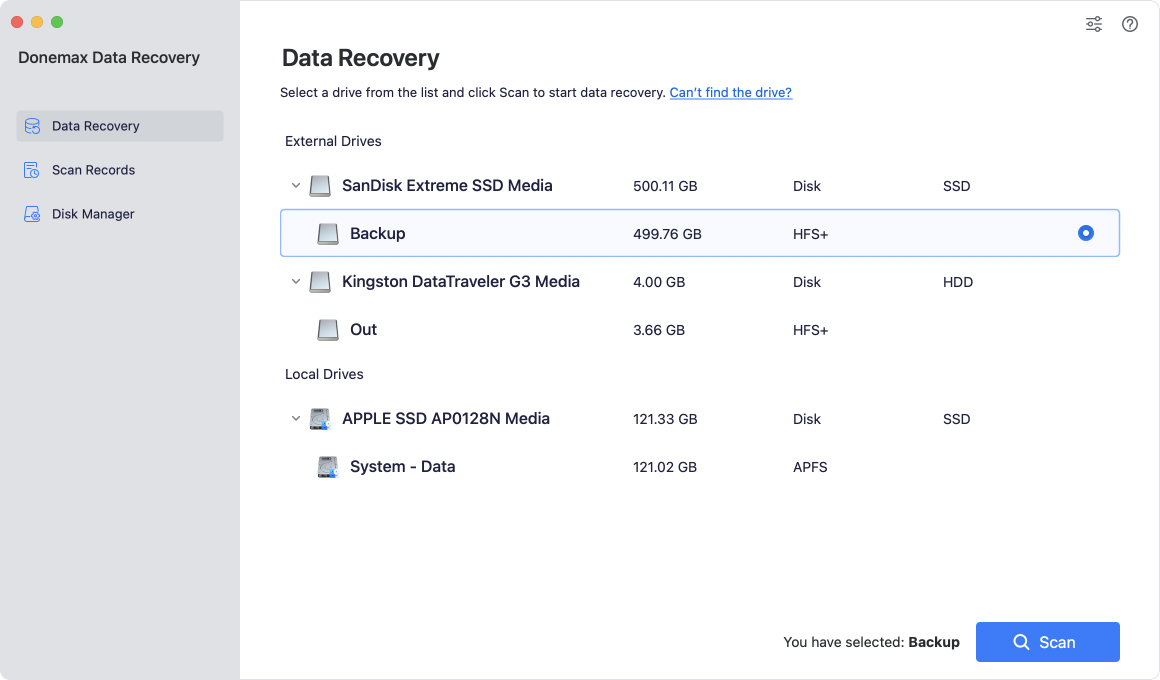Before we start: After the Final Cut Pro Projects are deleted or lost, first check the auto backups, storage locations, or restore from Time Machine backups. Otherwise, you can still recover the disappeared Final Cut Pro projects with the software Donemax Data Recovery for Mac.
PAGE CONTENT:
Final Cut Pro (FCP) is one of the most popular and professional video editing software used by filmmakers, video producers, and content creators worldwide. It offers a robust and feature-rich platform for editing, organizing, and rendering high-quality video projects. However, like any software, Final Cut Pro can sometimes encounter issues that lead to the loss or disappearance of projects. Whether caused by accidental deletion, a system crash, or corruption of files, losing a project can be an incredibly frustrating experience for video editors.

In this article, we will explore the most common causes of project loss in Final Cut Pro and provide step-by-step solutions on how to recover deleted or disappeared FCP projects. Additionally, we'll discuss preventive measures to ensure that you don't lose important projects in the future.
Common Causes of Lost or Deleted Final Cut Pro Projects
🗑 Unintentional Deletion
The most common cause of lost or disappeared Final Cut Pro projects is unintentional deletion. Users might inadvertently delete a project or library while cleaning up their workspace or managing files. It's easy to misclick and empty the trash, resulting in permanent deletion of files that were previously being worked on.
🖥 System Crash or Failure
System crashes and power failures are another major cause of project loss. When your system unexpectedly shuts down or experiences a technical glitch while you're working on a project, it may result in data corruption or the loss of unsaved work. These types of failures are unpredictable and can leave your project in an inaccessible state.
📃 Corrupted Files
Files can become corrupted for various reasons, such as software bugs, a faulty storage device, or issues during file transfer. A corrupted project file may make the project unopenable, and even if the file remains on the drive, it may be impossible to recover in its original state without intervention.
🔄 Improper Backup Management
Many users fail to regularly back up their Final Cut Pro projects, relying on their local storage or external drives as their sole storage solution. When backup systems are not properly set up or maintained, it becomes much more difficult to recover deleted or lost projects.
💾 External Storage Issues
Storing Final Cut Pro projects on external storage devices (such as hard drives, SSDs, or network-attached storage) introduces additional potential risks. External storage can be disconnected or malfunction, leading to missing projects. In some cases, external storage can even fail without warning, making it difficult to retrieve your work.
Preliminary Steps to Take after Losing Final Cut Pro Projects
Stop Using the Affected Storage
When you realize that your Final Cut Pro project is missing or deleted, the first thing you should do is stop using the affected storage device. Continuing to work on the same drive could overwrite the deleted or corrupted files, making it significantly harder—if not impossible—to recover them.
If the project was stored on an external drive, disconnect it immediately. If it was on your internal storage, try to refrain from using the computer for any work that could overwrite the lost files.
Verify External Drive or Cloud Storage
If you used an external drive or cloud storage to store your Final Cut Pro project, make sure that the project was not inadvertently moved or deleted from the storage device. External drives, especially portable ones, can become disconnected or misplaced. Similarly, cloud services such as iCloud or Google Drive might show outdated versions of the project, so it's a good idea to check if the project exists in a previous version stored on the cloud. Also, network storage systems often have file recovery or version control features that can help restore lost files. At last, make sure to check for hidden versions of the files.
Built-in Methods for Recovering Final Cut Pro Projects
Auto-Save Vault
Final Cut Pro has a built-in Auto-Save feature that can save your project at regular intervals, providing a safety net in case of unexpected errors. If your project disappeared due to a crash or power failure, there's a chance that Final Cut Pro's Auto-Save Vault has a backup of the latest version.
To check for auto-saved versions:
- Open Final Cut Pro and navigate to the File menu.
- Select Open Library and choose From Backup.
![recover deleted/lost Final Cut Pro projects]()
- Browse through the available backups to find a version of your project from before the deletion or corruption occurred.
![recover deleted/lost Final Cut Pro projects]()
Libraries and Backup Files
Final Cut Pro also maintains multiple versions of a project within the library, and often backups of these libraries are automatically created. These backup files can sometimes provide a reliable source for recovering lost projects. If your project has disappeared or been overwritten, you may still find earlier versions of it within the library folder. Look for the project file in the Backups section under the library, and check whether it contains older versions that can be restored.
Here's how to locate a backup library:
- Navigate to the folder where your Final Cut Pro library is stored.
- Look for a folder labeled Final Cut Backups.
![recover deleted/lost Final Cut Pro projects]()
- Open this folder and check for any backup versions of your project.
![recover deleted/lost Final Cut Pro projects]()
Time Machine Backup
If you use macOS, Time Machine is another useful tool to recover lost files, including Final Cut Pro projects. Time Machine automatically backs up your files and allows you to revert to a previous version of your entire system, including the specific Final Cut Pro project you may have lost.
To recover a project using Time Machine:
- Open Finder and locate the folder where your Final Cut Pro project was saved.
- Open Time Machine by clicking the Time Machine icon in the menu bar and choose Browse Time Machine Backups.
- Use the timeline to scroll back to a date before the project was deleted.
- Select and restore the project file to your system.

Using Terminal on macOS
For those comfortable with macOS's Terminal, there are a few command-line techniques that can help recover lost files. One such method is using the ls and find commands to search for hidden files that may still exist on the drive. This method requires a basic understanding of the Terminal and the file system structure.
Here's a simple way to search for hidden files:
- Open Terminal (from Applications → Utilities).
- Use the find command to locate files in the directory:
find /path/to/directory -name "*.fcpbundle"
- Review the results and attempt to recover any missing files.

Using Recovery Software to Recover Final Cut Pro Projects
If built-in recovery methods don't work, you can use third-party data recovery software. Tools like Donemax Data Recovery, Disk Drill, Do Your Data Recovery and Wondershare Recoverit specialize in recovering lost files from hard drives, SSDs, and external storage devices. These programs scan the storage device for deleted files and allow you to recover them if they are still present on the disk.
How to recover Final Cut Pro projects with recovery software?
Most data recovery tools work by scanning the storage device for "deleted" files. Even if a file is no longer visible, it may still exist on the drive as long as it hasn't been overwritten. Once the software completes its scan, it will display a list of recoverable files, which you can then save to a different storage location.
Here we will use Donemax Data Recovery as an example to show you the steps to recover deleted/missing Final Cut Pro projects:
Step 1. First download the software Donemax Data Recovery on your Mac. Double click the downloaded .dmg installation file and follow the guide to install it. If your Final Cut Pro projects were saved on an external drive, ensure to connect the drive to the Mac.
Donemax Data Recovery for Mac
- Quickly recover deleted/lost FCT projects or other files on Mac.
- Support data recovery for SD card, USB flash drive, SSD, HDD, etc.
- 100% safe and easy-to-use Mac data recovery application.
Step 2. Launch the data recovery software. It will show the connected drives. Check and ensure to locate the right drive where you lost the Final Cut Pro projects.

Step 3. After clicking on the Scan button, the software will deeply scan the drive to search for the missing Final Cut Pro projects.

Step 4. The software will list all the found files once the scan process is finished. Locate the Final Cut Pro projects which you want to recover. Then save them to another drive.

Precautions and Risks
While data recovery tools can be effective, they also come with some risks. Using the wrong software or relying on untrustworthy tools can result in further damage to your files. Additionally, recovery software may not be able to retrieve every lost project, especially if the data has been overwritten. It's crucial to use reputable software and to always back up recovered files before using them in Final Cut Pro again.
What to Do If Recovery for FCP Projects Fails
Contact Professional Data Recovery Services
If you've tried all the recovery methods without success, you may need to contact a professional data recovery service. These services specialize in recovering lost or corrupted data from malfunctioning hard drives, SSDs, and other devices. They have specialized tools that can extract files that typical recovery software cannot reach.
Consider Rebuilding the Project
If you cannot recover your project, you may have to rebuild it. You can try to gather the media files and other assets used in the project and start anew. While this may take time, it's better than losing everything entirely.
Prevention Measures to Avoid Losing FCP Projects
Regular Backups
The most effective way to avoid losing Final Cut Pro projects is to establish a regular backup routine. Use macOS's Time Machine for local backups, and consider using cloud storage services like iCloud, Google Drive, or Dropbox for additional redundancy.
Best Practices for Auto-Save and Version Control
Make sure to enable Auto-Save in Final Cut Pro and configure it to save your projects at frequent intervals. Additionally, manually create versions of your project as you work. This allows you to easily revert to a previous version if something goes wrong.
Organizing Media and Projects
Proper organization of your media and Final Cut Pro libraries is essential. Keep media files and project files in separate, well-structured folders. Label everything clearly to reduce the risk of accidental deletion or misplacement.
Using Reliable Storage Solutions
Invest in high-quality storage devices (such as SSDs) for storing your Final Cut Pro projects. Always make sure to verify the health of your external drives, and replace them regularly to prevent unexpected failures.
Conclusion
Losing a Final Cut Pro project can be a daunting experience, but it doesn't have to be the end. By using the built-in recovery tools, third-party data recovery software, or even professional recovery services, there are multiple ways to recover deleted or disappeared projects. However, prevention is always better than cure—establishing a solid backup strategy, using reliable storage, and regularly organizing your projects will help minimize the risk of future data loss. Remember, the key to avoiding project loss is preparation and consistent backup management.


Donemax Data Recovery for Mac
Donemax Data Recovery for Mac is one of the best Mac data recovery software. It is easy-to-use and can help in recovering deleted, formatted, inaccessible or lost data from Mac HDD/SSD, external disk, USB drive, SD card, camera or other storage devices.
Related Articles
- Nov 29, 2024Mac Trash Recovery: A Comprehensive Guide to Recovering Deleted Files on Mac
- Feb 12, 2025[2025 Updated] Top 4 Seagate File Recovery Solutions for Mac
- Jan 05, 2025Files on Mac Desktop Disappeared: How to Recover Them? [4 Methods]
- Nov 11, 2024How to Recover Deleted Photos on Mac? 5 Solutions to Try
- Jun 11, 2024Best Free Seagate Data Recovery Software for Mac
- Feb 12, 2025Word Documents Disappeared from My Mac? How to Recover Them? [8 Methods]

Coco Lin
Coco has been a writer and a chief programmer at Donemax software since 2018. Over 10 years of experience of writing troubleshooting articles in the software industry, she is passionate about programming and loves to providing solutions to Windows and Mac users. Also she enjoys music and palying tennis in her free time.

Gerhard Chou
In order to effectively solve the problems for our customers, every article and troubleshooting solution published on our website has been strictly tested and practiced. Our editors love researching and using computers and testing software, and are willing to help computer users with their problems



